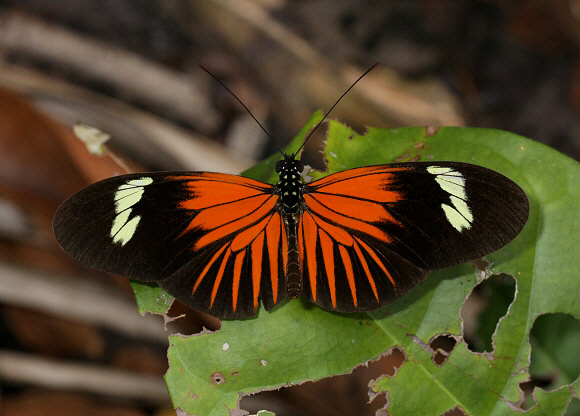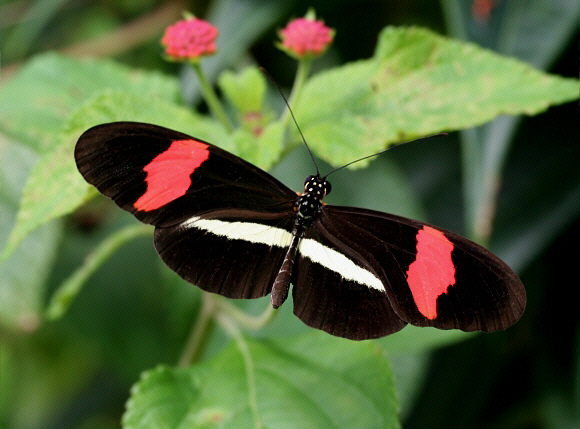Morphological species
In past times any two butterflies that looked identical in structure and markings were assumed to be the same species, and named accordingly. However we now know that there are many species involved in “mimicry rings” whereby several different species can produce visually identical adults.
Conversely we also know that it is quite common for a single species to produce several different forms or morphs, which previously might have been classified as different species. A good example of this phenomenon is the African Mocker Swallowtail Papilio dardanus – the male is cream in colour and possesses tails on the hindwings.
The female however lacks tails, and produces several forms, each differing in colour and pattern, but all mimicking various species from the Danaine genera Danaus and Amauris, and the Acraeine genus Bematistes.
Another problem with morphological species is that apparently identical adult butterflies can have early stages ( eggs, caterpillars, chrysalises ) that differ in structure. Taxonomists therefore began to examine the full lifecycle rather than just the adult butterflies, and consequently several new species were discovered, e.g. the Clouded Yellows Colias alfacariensis and C. hyale were thought to be the same species until Berger discovered distinct differences in the larvae and pupae.
Closely related morphological species can sometimes be visually indistinguishable, making it almost impossible to determine whether they represent varieties / subspecies of one butterfly, or whether they are biologically different ( but visually identical ) species.
Biological species
These are defined as creatures which breed with other biologically identical creatures, and produce fertile offspring. To prevent interbreeding, each species of butterfly has uniquely shaped genitalia – the male “key” only fitting the correct female “lock”. The males and females of some butterflies are totally different in appearance, and may not initially be recognized as belonging to the same taxon. By examining the genitalia, taxonomists have often discovered that 2 insects previously classified under entirely different genera are actually the same biological species!
Hybrids
Despite Nature’s mechanisms for the prevention of interbreeding, hybridization between species does occasionally occur. Hybrids however are always infertile, so they are unable to pass on their characteristics to another generation.
Cladistics and phylogenetics
Cladistics is a system whereby comparative data is analysed quantitatively and is used to construct cladograms, dendrograms and matrices. These are visual representations of the evolutionary tree of life and are used to depict the assumed evolutionary relationships between groups of organisms.
In simple terms, if two sample specimens were analysed and found to share only a low number of common characteristics, this would imply that they were only distantly related, i.e. that they split from their common ancestor a very long time ago. At the other extreme, if the number of shared characteristics was high it would imply that the specimens were closely related, having split from a common ancestor relatively recently.
Hence they would probably be placed in the same genus. For both insects to be recognised as the same species, ALL of the characteristics would of course have to be identical.
Since the late 20th century phylogenetic analysis has increasingly been used to differentiate species and to establish evolutionary relationships between various subfamilies and genera. A biologist will typically begin by analyzing 100 or so different characteristics. These could include anything from the spikes on a butterfly’s leg to the structure of the eyes, the presence or absence of a branching wing vein, or the chemical content of the larval foodplants.
From this initial list of 100 characteristics the biologist will then select about 40-50 that experience indicates should be the most reliable for the final analysis.
These are each weighted according to their perceived relevance to the study. Computers are then used to perform complex algorithms which determine the “distance” between closely related genera, tribes or species. The selection of characteristics used has a dramatic impact on the outcome of an analysis. It is virtually unknown for two or more studies to produce identical results. Consequently while there is general agreement about higher level ( superfamily : family ) classification, there are wide differences of opinion about the relationships between various genera, tribes and species.
Genetic interchange
Butterflies can loosely be divided into 3 camps regarding genetic interchange:
The first group comprises species such as the Painted Lady Vanessa cardui, the Small White Pieris rapae and the Pea Blue / Long-tailed Blue Lampides boeticus which are migratory in behaviour and cosmopolitan in distribution. Their nomadic nature brings them into fairly regular contact with distant “cousins” of their own species, so genetic interchange occurs frequently. A Painted Lady in Australia therefore is genetically almost identical to a Painted Lady in Europe, Africa, Asia or North America. Accordingly all races are designated as Vanessa cardui, and there are no recognised subspecies.
The second group comprises of endemics – species which are native to and confined to a limited area such as a particular island or mountain range.
Examples include Calisto confusa which is found only in Haiti; Baronia brevicornis, found only in deciduous scrub forests of s.w. Mexico; Eresia sticta which is restricted to Costa Rica; and Henotesia comorensis – a butterfly confined to the Comoro Islands north-west of Madagascar. By definition endemics have no other races of their own species with which they can interbreed, so there are no subspecies.
The vast majority of butterfly species fall into the third group, which comprises those species which are quite widespread in distribution, but whose populations, due to changes in climate or vegetation have become isolated from each other for hundreds or thousands of years.
Such populations have little opportunity to interbreed, so genetic interchange is minimal, and accordingly each isolated population develops its own characteristics. The Scottish race of the Large Heath e.g. lacks ocelli on the wings and is known as Coenonympha tullia scotica, while the race from Bosnia-Herzegovina has very prominent ocelli, and is recognised as a different subspecies Coenonympha tullia lorkovici.
The subspecies phenomenon is particularly prevalent in South America, where areas of rainforest have during several periods of the Earth’s climatic history become isolated as a result of glaciation or desertification.
The result of this long term separation of populations is particularly noticeable in the genus Heliconius. In the case of Heliconius erato there are no less than 29 subspecies, each with a different pattern. Each subspecies of erato corresponds in colour and pattern with one of the 29 subspecies of another Heliconius species – H.melpomene.


If populations have been isolated for several millennia the differences between them can be very pronounced – patterns, colours, size, and even the shape of the wings can be different, particularly if the races evolve in different habitats and climates.
Sometimes, due to the periodic contraction and expansion of forested areas, subspecies which have been isolated for many thousands of years can be reunited, so that their ranges of distribution overlap.
Thus it is possible, and in fact not uncommon, to find more than one subspecies occurring in the same area of forest.
By definition, all subspecies of any given species are physically capable of interbreeding and can produce fertile offspring. Although such interbreeding may not necessarily occur naturally, it can be induced in captivity.
Some evolutionists argue that if a subspecies becomes isolated for a long enough period of time, it will ultimately evolve structural differences ( e.g. in the genitalia ) that make it physically impossible for it to interbreed with other subspecies, and that if and when this occurs the 2 forms have become sufficiently different for them to be reclassified as separate species, i.e. the evolution of a new species will have occurred.
Others argue that DNA analysis of various subspecies on remote islands in Melanesia indicates that when populations become isolated, inbreeding and genetic entropy occurs, which is contradictory to most theories of evolution, which state that as species evolve they advance – thereby increasing rather than decreasing the number of chemical base pairs in their genome.
